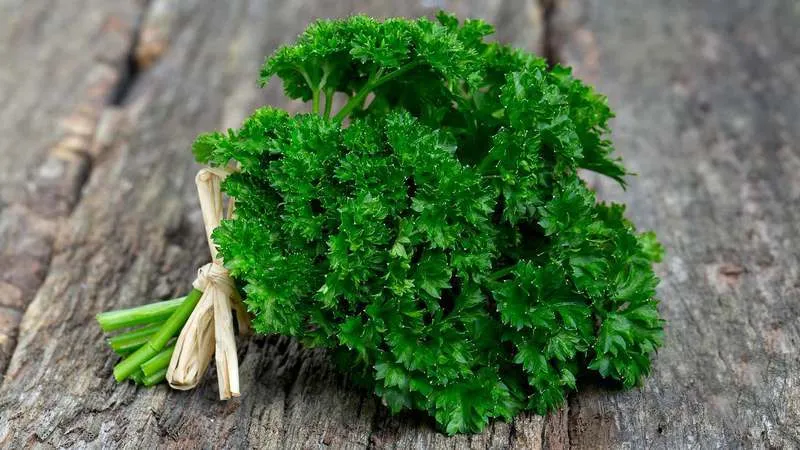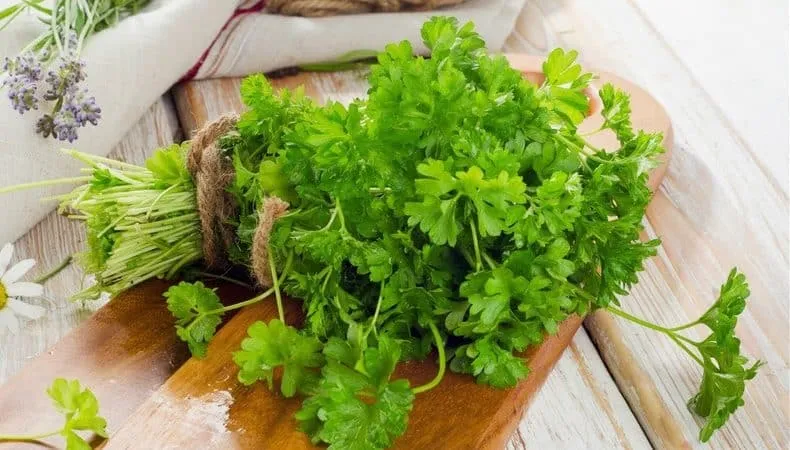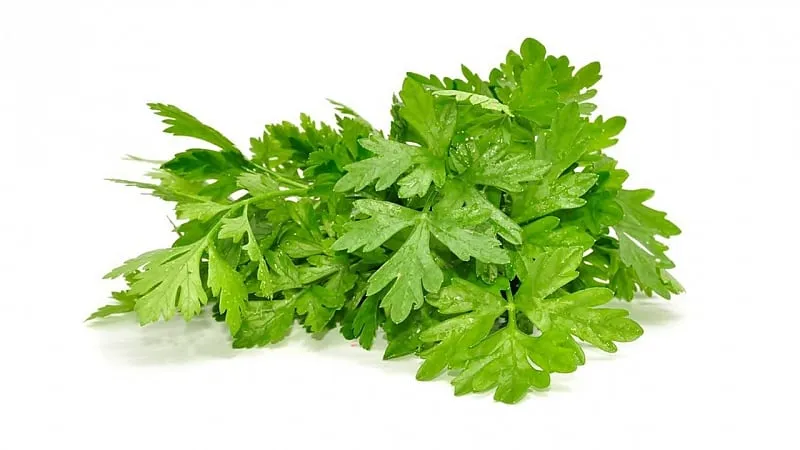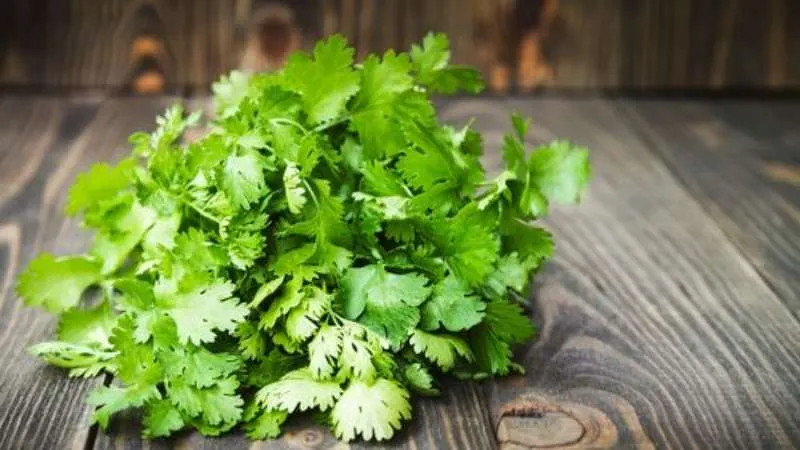Parsley thrives even in rocky soils, making it very convenient to grow. In cooking, there are two main types of the plant — curly and Italian flat-leaf. The former has crinkled leaves with a slightly bitter taste, while the latter has flat leaves with a pronounced aroma.
In this article, we will explore the chemical composition of parsley, its health benefits, medicinal properties, potential side effects, and contraindications.
Table of contents
Composition of Parsley

If the herb is grown without excessive chemical fertilizers or growth accelerators, it can be highly beneficial.
100 g of parsley contains the following vitamins:
- K — 658% of the daily value;
- C — 431%;
- Beta-carotene — 111%;
- B1 — 7%;
- B2 — 17%;
- B6 — 10%;
- B9 — 29%;
- E — 18%.
The leaves and stems of parsley are rich in macronutrients such as:
- Silicon — 50%;
- Potassium — 24%;
- Calcium — 20%;
- Magnesium — 16%;
- Phosphorus — 10%;
- Sodium — 9%;
- Chlorine — 7%.
Key trace elements in parsley include:
- Manganese — 155%;
- Boron — 107%;
- Vanadium — 61%;
- Iron — 48%;
- Nickel — 43%;
- Rubidium — 42%;
- Cobalt — 41%;
- Lithium — 21%;
- Iodine — 17%;
- Chromium — 16%;
- Copper — 12%;
- Zinc — 11%.
The roots have a less rich composition but are still beneficial. They contain:
- Vitamins K, C, and B-group;
- Potassium, silicon, phosphorus, calcium, magnesium;
- Boron, vanadium, manganese, copper, rubidium, zinc, cobalt.
Caloric Content and Nutritional Value
The caloric content of parsley leaves is low — 36 kcal per 100 g. The roots have a slightly higher value — 51 kcal.
Nutritional value per 100 g is presented in the table:
| Nutrients | Leaves | Roots |
| Protein | 3.2-4.5 g — 5% | 1.5 g — 3% |
| Fats | 1.2 g — 1% | 0.6 g — 1% |
| Carbohydrates | 4.6-10.2 g — 2% | 13.3 g — 5% |
The glycemic index of parsley leaves is 5, while the roots have a GI of 10. This is low compared to dill (15), radish (15), or cucumber (20). Parsley is suitable for people with diabetes.
The polysaccharide inulin, found in parsley, helps regulate blood sugar levels.
Is Parsley Good for Weight Loss?
Parsley is low in calories, making it ideal for those monitoring their weight or trying to lose it. The plant has a diuretic effect — infusions made from its leaves, stems, seeds, or roots help flush excess water from the body. This reduces swelling and helps regulate weight.
Important! Overusing diuretic infusions is not recommended, as valuable nutrients are also lost. The product should be used systematically; otherwise, excess fluid will accumulate again.
Dietary fiber in parsley suppresses appetite, reducing daily calorie intake. The body is cleansed of cholesterol and toxins. Subcutaneous fat metabolism is stimulated, helping to reduce cellulite. Parsley infusions also calm the nervous system, making even strict diets more manageable.
The plant can be used in infusions, decoctions, or teas. Leaves and stems are added to salads and soups. Parsley can be consumed fresh, dried, or frozen.
Health Benefits of Parsley
Parsley contains more vitamin C than lemons and other citrus fruits. It boosts immunity and has antioxidant properties.

Some of the health benefits include:
- Lowering blood sugar levels;
- Supporting digestive health;
- Aiding in kidney stone removal;
- Preventing cardiovascular diseases;
- Antiseptic properties;
- Regulating hormonal balance;
- Eliminating bad breath, healing wounds, and reducing inflammation;
- Revitalizing and cleansing the skin;
- Reducing swelling and pain from insect bites.
Parsley is beneficial for people with high mental or physical stress and chronic sleep deprivation. It improves oxygen balance and stabilizes brain function.
For Women
Parsley helps relieve muscle spasms and pain during menstruation. Folic acid supports reproductive health and proper fetal development during pregnancy.
Important! Pregnant women should consume parsley in moderation, as it increases blood circulation in the pelvic area and may raise the risk of premature birth or miscarriage.
For cystitis prevention or symptom relief, parsley leaf and stem decoctions can be used. However, it should not replace prescribed medications.
For Men
Parsley positively affects male reproductive health. The bioflavonoid apigenin reduces estrogen levels, boosts testosterone production, and has strong antioxidant properties, helping prevent prostate cancer and other conditions.
Regular consumption reduces the risk of cardiovascular diseases. Parsley also helps detoxify the body after alcohol consumption.
For Children
Parsley retains its benefits even after light cooking. Essential oils enhance resistance to viral infections. Vitamins A and E promote faster wound healing.
Iron, chlorophyll, and folic acid improve blood quality, which is beneficial for children with anemia. Potassium and magnesium regulate blood pressure, heart function, and muscle tone.
In adolescence, parsley helps cleanse the skin — reducing acne, blackheads, and freckles. It can be used in masks or simply added to the diet.

Which Parts of the Plant Are Used?
Depending on the recipe, roots, stems, leaves, or seeds are used — soaked or boiled.
Fresh parsley offers the most benefits. However, in winter, it can be preserved by canning, salting, drying, or freezing (chopped or in ice cubes).
Usage and Recipes
All parts of parsley are used in medicine, cosmetics, cooking, and even household applications. Popular varieties include Bead, Titan, and Rialto.
For Weight Loss
Parsley is best used for weight loss alongside a balanced diet and exercise. Here are some recipes:
Choose based on preference:
- Decoction: Boil 50 g of chopped parsley in 1 L of water for 5 minutes. Cool, strain, and drink 200 mL 15 minutes before meals.
- Infusion: Steep ½ tsp of seeds in a cup of boiling water for 10 minutes. Drink 180 mL twice daily.
Fresh or frozen parsley can be added to soups or salads.
In Cosmetics

Parsley contains skin-beneficial elements:
- Carotene protects against UV rays and maintains skin elasticity;
- Vitamin PP enhances oxygenation and blood circulation;
- Vitamin B2 promotes skin cell renewal.
Nourishing Mask: Mix 30 g of chopped parsley with 100 g of sour cream, apply for 15–20 minutes, then rinse with cool water.
In Folk Medicine
Parsley root is used in folk medicine for heart health. Decoction: Steep 40 g of chopped root in ¼ cup of boiling water for 12 hours, strain, add 10 g of honey, and take 15 g four times daily before meals.
Household Uses
Parsley juice can dye Easter eggs green. In gardens, it repels aphids and can be used as fertilizer.
Potential Side Effects and Contraindications
Main contraindications include allergies and acute urinary or digestive conditions. Excessive consumption may cause headaches, nausea, or weight loss. The daily limit is 100 g.
Conclusion
Moderate parsley consumption alleviates urinary issues, strengthens the heart, improves mood, and enhances appearance. Both adults and children benefit from its leaves, stems, roots, and seeds.







